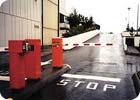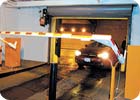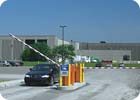A Gated Welcome, Plus

A diversity of security technologies can protect the
entrance to facilities as well as collect data on people
and vehicles entering a facility.

Gates are a solid and typical security protection at the entrance to facilities, parking lots and garages. The equipment can easily integrate with other security and financial systems. Photos courtesy of Automatic Systems
The most typical security solution is a gate.
Outdoor perimeter security installations can be some of the most challenging. Real-world experience frequently is the most valuable when dealing with the necessity of weather-tight, reliable installations that have to withstand everything from landslides to hurricanes. Perimeter security encompasses a number of different technologies. Some installations use active infrared, photoelectric or other types of beam detectors, sometimes in combination with passive infrared (PIR) motion detectors.

Installed in tens of thousands of locations worldwide, the most typical gate operators are extremely reliable, and designed for continuous operation. Most are compatible with access control devices. Most gate arms can span openings of up to 30 feet, according to technicians at gate makers.
Numerous security and safety features are standard: durable crank and shaft operating mechanism, security locking in upper and lower positions, safety clutch, electronic controllers, all in corrosion protected cabinets. Gate arms are aluminum tube.
Some chief security officers need specialty gates. For example, what if you need to open a gate in half a second or span a road 45 foot wide?
In environments requiring extremely fast operation, such as toll roads, many security gates can withstand 15,000 high-speed operations a day. Variable speed controllers, snap-out gate arm, and automatic opening on power failure are just a sample of the available features. Wide access points requiring access or security barriers can be controlled with gate operators with very long arms. Gate and gate operator accessories can include electromagnetic tip support, boom lights and fencing, among other gear.

COMPLEMENTING GATE CONTROLS
Some facilities – often critical infrastructures – bolster gates and fences with higher-level security technology.For example, after a terrorist threat on a propane gas facility in California was discovered before its implementation, a sophisticated microwave detection system was installed along with a fence detection system as part of a complete security upgrade at a California propane storage facility.
“We are the largest above-ground refrigerated propane storage facility west of the Mississippi,” asserted Pat Hicks, facilities manager at Suburban Propane, Elk Grove, Calif., which is approximately 16 miles south of Sacramento. “This facility stores approximately 24 million gallons of propane, and all we are is a storage facility. The product comes in the summer and goes out in the winter.”

Geno Bartley, owner and field technician for GB Technical, Newport, Ore., was called in. The solution was to isolate the electronic circuit boards of the existing fence system from the noise with nylon washers and screws and install a new interconnect cable. Next in the electronic line of defense were infrared beam detectors, which also were installed by the previous security contractor, but because of occasionally foggy conditions at the site, they were replaced with a microwave detection system installed by Bartley’s company.

Because of this, the railroad entrance at one end of the facility posed a challenge. “The railroad tracks stick up kind of tall and that blocks the multipath, so if microwave travels across ground and has something in the way that blocks it, a low-profile person might be able to beat it,” Bartley relates. “Microwaves need a relatively level area between transmitter and receiver.”
Instead, two dual-channel stereo Doppler microwaves overlap each other with a teardrop-shaped detection.
Looking for a reprint of this article?
From high-res PDFs to custom plaques, order your copy today!







